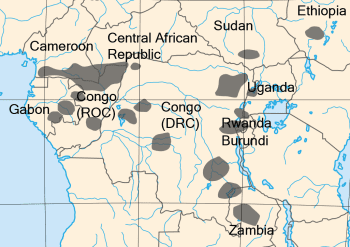 Once distributed throughout tropical Africa, Pygmies now live in pockets of the continent’s rainforest.
Once distributed throughout tropical Africa, Pygmies now live in pockets of the continent’s rainforest.
Africa is home to a number of dwindling hunter-gatherer populations, most of them living deep in the rainforests that stretch from western Africa’s Atlantic coast to the eastern edge of the Democratic Republic of Congo. Known as “Pygmies” because of their short stature, previous studies (including one funded by 23andMe) have shown that these forest-dwelling groups are descended from populations that arose 20,000 to 50,000 years ago.
But today populations such as the Mbuti, who live in the eastern forest, speak radically different languages from those spoken by the Biaka and other groups who live in the west. In fact, the Biaka speak a language belonging to the Niger-Congo linguistic family, which is associated with the expansion of agriculture throughout sub-Saharan Africa less than 5,000 years ago.
How did a hunter-gatherers in the African rainforest end up speaking less like their distant cousins and more like their farming neighbors? A paper published last month in Current Biology offers an explanation by genetically modeling the population history of the western African Pygmies and their farming neighbors using autosomal DNA, which is inherited from both parents.
Verdu and colleagues suggest that for most of the last 50,000 years western Pygmy groups were a single population, exchanging marriage partners and migrating through large tracts of the western forest. They also suggest that, contrary to earlier studies, the western African Pygmies were isolated from non-Pygmy populations until about 2,800 years ago, when they began exchanging marriage partners with neighboring farming populations.
Today, social taboos discourage Pygmy men from taking wives belonging to neighboring farming groups. But farming men and Pygmy women can marry, and sometimes the children of these unions sometimes return to their mother’s natal group in the forest. These cultural taboos and the resulting sex-biased gene flow probably began after western Africans invented farming techniques and began expanding through the rainforests about 5,000 years ago.
The research by Verdu and colleagues is the first to put a date on the breakdown of western Pygmy migration patterns due to the expansion of farmers – about 2,800 years ago. The integration of western Pygmy groups and farmers is also reflected in the linguistic similarity between the groups; both speak Niger-Congo languages. It is generally assumed that this linguistic shift occurred as farmers and hunter-gatherers intermarried.
The original languages of these western Pygmies have now been lost. But because Pygmy women have been marrying into farming groups for millennia, their genetic signature is well preserved in both populations. Using mitochondrial DNA, which is passed down from mother to child, genetic researchers discovered that over 80% of western Pygmies carried lineages derived from haplogroup L1c1a. About 20% of farmers from neighboring villages in western Africa carry the same haplogroup as evidence of their Pygmy maternal ancestry.
Could you have Pygmy ancestors? That’s difficult to say. About 12% of African Americans carry mitochondrial DNA lineages belonging to haplogroup L1c, which indicates maternal ancestry somewhere in the Congo basin and surrounding areas, but not Pygmy ancestry per se. Absent a confirmed assignment to L1c1a, the odds are that the maternal ancestry of an African American individual in haplogroup L1c traces back to farming rather than Pygmy populations.



